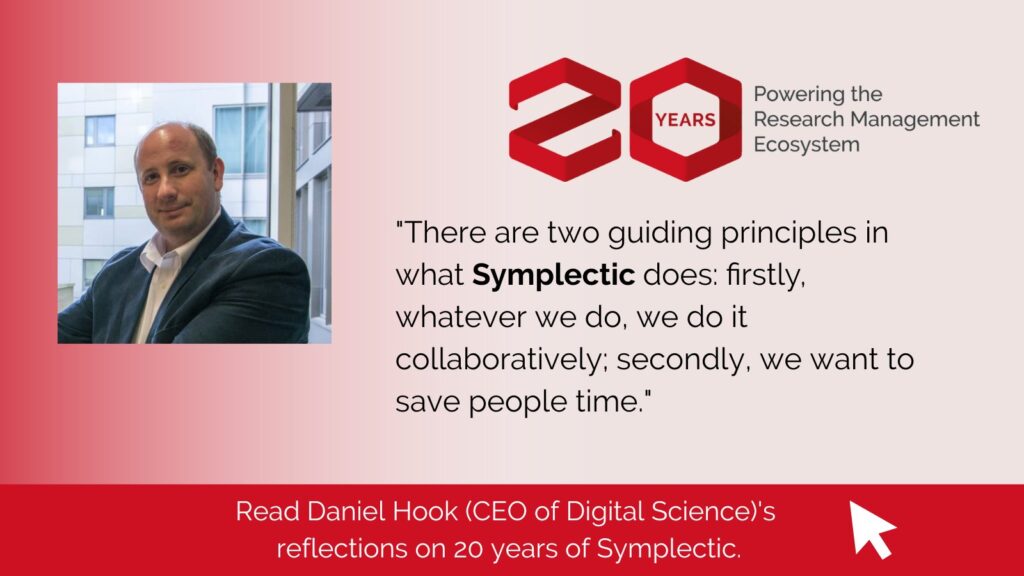Subscribe to our newsletter
Symplectic at 20: Thoughts from Digital Science’s CEO
Daniel Hook, one of the co-founders of Symplectic and now CEO of Digital Science, reflects on the past 20 years of growth and change at Symplectic – and what makes it such a special partner within the research community.
Twenty years is a long time in tech but a short time in the world of research. There are other, perhaps more appropriate measures by which to measure the age of Symplectic: in UK terms, Symplectic is ‘three REFs’ old, from a New Zealand perspective it is just two PBRFs, and in an Australian context it is four (and a bit) ERAs old. From a software development perspective, Symplectic is six major versions old. From a client perspective, it is more than 120 installations old. From a personal perspective, it is two CEOs old – indeed, around Christmas this year, I will become the second-longest serving CEO of Symplectic, having moved into the Digital Science leadership team in 2015 and handed the reins of Symplectic over into the capable hands of Jonathan Breeze.
As with almost any 20-year-old, this one, which was started by four friends who happened to share an office while doing their PhDs, has grown so as to be almost completely unrecognisable. And yet, there are things that were important to us when we founded the company 20 years ago that remain at the heart of what we do now. I like to think that there are two guiding principles in what Symplectic does: firstly, whatever we do, we do it collaboratively; secondly, we want to save people time. There are other things that flow from this: bringing an academic perspective; helping people to make better decisions; ensuring that data are re-used; making sure that we preserve key aspects of choice in how users of Elements are able to work with the data that it contains; interoperability between systems and so on. At the core each of these things is an expression of those two guiding principles.
Setting collaboration at the centre of Symplectic’s world has created a very special ethos in the company, as both those inside the company and those who work with Symplectic’s team will attest. Symplectic’s story is not just about those of us who founded the company or those of us who have been part of the team – it is a story that is shared with Symplectic’s wider community. There are simply too many people to name who have played pivotal roles in making Symplectic the company that it is today. I know this because, in preparation for this blog, I tried to write such a list and found myself with more than 50 names of people simply from my time as CEO in the first ten years of Symplectic. And, that list specifically did not include the many colleagues and friends who were actually part the Symplectic team itself over that period. I can only imagine that Jonathan Breeze, my successor, has a list at least as long as the company has expanded significantly under his tenure. All these contributors have made Symplectic what it is today.
Symplectic enjoys a special level of collaboration with its clients, partners, friends, and colleagues. So many over the years have taken a long view – not solely focusing on their own project or installation but giving their time and knowledge generously. This has not only created a company and a piece of software, but also a shared store of deep domain knowledge. Every relationship has gone toward ‘paying it forward’ so that the broader Symplectic community benefits from the innovations and ideas of each participant. When once, in the early phase of Symplectic’s development around 2008, a perceptive UK-based client observed, “You’re really just centralising development funding from many universities so that you can give us a great product and keep it moving forward in a way that we can afford”, they were not wrong.
Our second focus of saving people time sits as a key part of this collaborative relationship. In that regard, Symplectic has moved from serving a single institution in 2003 to being fortunate enough to collaborate with institutions around the world to help them save time for their researchers.
Symplectic’s work is trusted around the world, saving time every day for more than 500,000 academics and administrators in 18 countries. The clients of Symplectic hold more than 8.8m distinct publications sourced from different data sources, saving academic and administrative time every time an article is added to their Symplectic Elements system, full text is deposited, or data is reused in other systems to inform decisions, help annual reviews or advertise the expertise of colleagues to potential partners around the world. With the help of Dimensions, I estimate that:
- Just over 7% of global annual output is recorded by organisations in a Symplectic Elements system in an automated way that minimises the time to rekey research metadata records.
- 23% of global green open access articles are associated with at least one Symplectic Elements instance, saving time for academics to deposit their work into institutional repositories.
- 17.5% of global citations land on articles stored in Symplectic Elements instances, while 15.5% of Nature papers are captured in Elements instances.
- Approximately 64% of articles associated with Symplectic’s clients have an Altmetric mention (compared to a global average of 27%).
- 72.5% of New Zealand’s research article output is captured in a Symplectic Elements system, as well as 74% of funder-acknowledging publications, and almost 81% of New Zealand’s University-produced research.
It has been an honour to work with the Symplectic team over the last 20 years. To see their progress, their dedication, and their spirit. As you see, they have carved out a unique path and make a real impact in the world with the people that they support. Here’s to the next 20!
And, of course, to borrow a phrase… Vive la Symplectic!
This post was originally published on the Symplectic website here.

About the Author
Daniel Hook, CEO | Digital Science
Daniel Hook is CEO of Digital Science, co-founder of Symplectic, a research information management provider, and of the Research on Research Institute (RoRI). A theoretical physicist by training, he continues to do research in his spare time, with visiting positions at Imperial College London and Washington University in St Louis.

